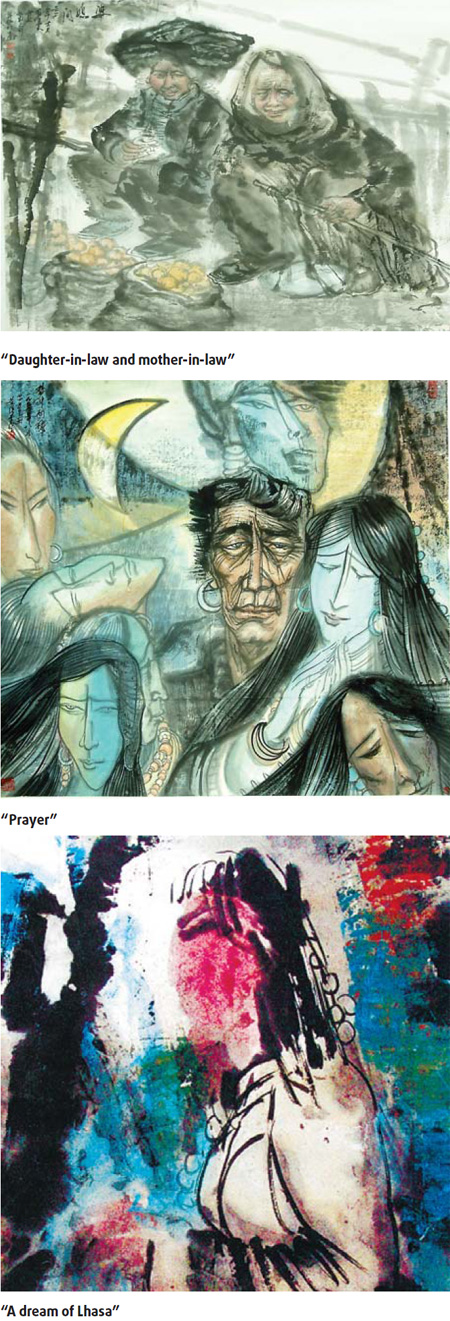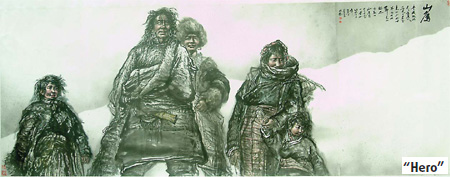
|
CHINA> China and World
 |
|
Chinese Olympic painter takes French art world by storm
By Zhu Chengpei (China Daily)
Updated: 2009-09-10 08:51
 In April this year an exhibition by a Chinese artist became the talk of the art world in Paris. Visitors to the gallery showcasing his work were said to be entranced by his works raw, natural and vivid power, seeing it as having an underlying universality whilst simultaneously being deeply Chinese in its idiosyncrasy. The artist in question was Huang Cangsu, a famous Chinese painter from Dalian, Northeast China's Liaoning province. His exhibition - "Harmonious World - 2009 Huang Cangsu's Individual Art Exhibition" - was jointly organized by the News of Europe and the Dalian Wanli Technology and Culture Communication Service Center. It was held in the French capital's Chinese Culture Center and highlighted the artist's concerns with the themes of nationality, originality, harmony and humanity. It featured as part of a showcase highlighting China's thousands of years' cultural heritage, as well as providing an insight into the every day life of contemporary Chinese people.
Robert Arnaut, a well-known French author, congratulated the artist on his visionary work. Arnaut said he had taken his family to see the exhibition three times and said the artist's works had emotionally gripped all of them. Commenting on the exhibition, Arnaut said: "All of my family were fascinated by the quality of Huang's work and his unique blend of themes and styles." Philippe Bosc, from French Parliament, said Huang's show was the most successful and outstanding art exhibition of all the considerable number of Chinese artists who had staged exhibitions in Europe over the past 30 years. Huang's works have long been celebrated for their fusion of western and Chinese motifs. His work has been seen as deeply experimental for several years now and has been seen by many as representing a wholly new and original style of painting Gilles Diffand, a professional, said that Huang's work was highly diverse and demonstrated a breathtaking mixture of ancient traditions, as well as abstract and western styles. Discussing his own work, Huang said: "As a painter, the works enables me and anyone who views them to get close to art, life and the human soul." Huang takes his inspiration from his personal life and China's contemporary social issues. He was born in 1961 and grew up in Taizhou city in eastern China's Zhejiang province. When he was only four years old, whilst living in up in a small wooden house, Huang was inspired by his father to start using a paintbrush and he began painting on old newspapers. To support his growth as an artist, his mother sold their home's only valuable item - a sewing machine. She used the money she raised to buy painting materials for Huang.
 Huang's earliest works were inspired by his father and mother. Looking back now, he says: "My father's hopes and expectations are still the key inspiration for my artistic career. He encouraged me to continuously seek out the true quintessentials of art." One of Huang's most striking abilities is his power to capture characters on canvas. One of his most remarkable works is a picture simply entitled: "Mother". Reflecting on the power of the portrait, one Chinese arts critic wrote: "In Huang's picture, the mother is depicted as a virtuous, traditional and typical Chinese loving mother. On her face, you can find no trace of a smile or a tear, but lot of hopes. The lady he drew is possibly his mother." During his 40-year art career, Huang has traveled all around the country. He has been to the Qinghai-Tibetan Plateau seven times in a bid to really understand the life of the local people in the area. As a result, he has created a series of works depicting the Tibetan autonomous region and the people who live in western China. One visitor to the gallery who was familiar with Tibet said: "I like the exposition very much, especially the paintings of the Tibetans and the China nature studies."
 After Beijing's successful bid for the 2008 Olympic Games, Huang created the memorable work: " The first Chinese team in the history of the Olympic Games". This illustrated the story of a Chinese professor, Shu Hong, who organized the country's first sports team to participate the Olympic Games, back in 1936. In another series of works, Huang combined a group of Chinese icons, including the landscapes of the Yellow River, the Yangtze River and the Great Wall, with a group of Chinese Olympians. It was a great showcase for the spirit of the sports event and concept of nationality in Chinese people's minds. Describing the work, Huang said: "It was my way of showing all Chinese people's expectations, with regard to sponsoring and participating in the Olympic Games. "My life, my work and the development of my artistic career are really connected with China's contemporary social issues. The work I did relating to the Beijing Olympic Games is the best example of this."
 |